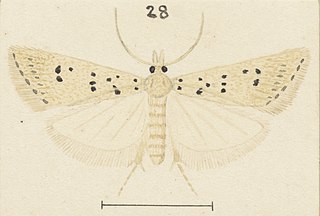
Heterocrossa maculosa is a species of moth in the family Carposinidae. It is endemic to New Zealand. It is classified as "Data Deficient" by the Department of Conservation.

Circoxena ditrocha is a species of moth in the family Blastodacnidae. This species is endemic to New Zealand and has been collected on both the North and South Islands. The habitat of this species is on the edges of native forest or scrub and it may be associated withPseudopanax arboreus. As at 2000 the host species of this moth is unknown but it has been hypothesised that the larvae are seed borers. Adults are on the wing in December to March. It is classified as "At Risk, Naturally Uncommon" by the Department of Conservation.

Glyphipterix necopina is a species of sedge moth in the genus Glyphipterix. It is endemic to New Zealand. It is classified as Not Threatened by the Department of Conservation.
Phaeosaces lindsayae is a species of moth in the family Depressariidae. It is endemic to New Zealand. It is classified as "Data Deficient" by the Department of Conservation.

Stathmopoda albimaculata is a species of moth in the Stathmopodidae family. It is endemic to New Zealand and is located in the lower half of the South Island. This species favours habitat that includes the various Olearia species that host its larvae. It has also been found to inhabit lowland podocarp native forest. The larvae feed on species in the genus Olearia. Adults are on the wing between the months of October and February. S. albimaculata is classified as Nationally Endangered by the Department of Conservation.

Archyala opulenta is a species of moth of the family Tineidae. This species is endemic to New Zealand has been found in the upper Maitai Valley in Nelson as well as in Northland. The larvae of this species are associated with endemic bat species as they feed on the guano of Mystacinidae. The adult moths are on the wing in November. It is classified as "Data Deficient" under the New Zealand Threat Classification System by the Department of Conservation.

Archyala lindsayi is a species of moth in the family Tineidae. This species is endemic to New Zealand. It is classified as "At Risk, Naturally Uncommon" by the Department of Conservation.

Orocrambus ornatus is a moth in the family Crambidae. This species is endemic to New Zealand. It is classified as critically endangered by the Department of Conservation.

Pyrgotis transfixa is a species of moth of the family Tortricidae. It is endemic to New Zealand. It is classified as "At Risk, Naturally Uncommon" by the Department of Conservation.

Kiwaia hippeis is a moth in the family Gelechiidae. This species was first described by Edward Meyrick in 1901. It is endemic to New Zealand and has been collected in Christchurch. Adults of this species are on the wing in December and are attracted to light.
Kiwaia jeanae, also known as the Kaitorete jumper or mat daisy jumper, is a species of moth in the family Gelechiidae. It is endemic to New Zealand. This species is classified as "At Risk, Naturally Uncommon" by the Department of Conservation. Both the males and females of this species are brachypterous.

Eutorna inornata is a moth in the family Depressariidae. It was described by Alfred Philpott in 1927. It is endemic to New Zealand and has been observed in both the North and South Islands. The larvae of this moth are leaf minors of Selliera radicans.

Pseudocoremia fluminea is a species of moth in the family Geometridae. It is endemic to New Zealand. It is classified as Not Threatened by the Department of Conservation.

Sagephora jocularis is a species of moth in the family Tineidae. It was described by Alfred Philpott in 1926. This species is endemic to New Zealand and has been collected in Canterbury and Southland. Adults are on the wing in January and October.

Cnephasia paterna is a species of moth in the family Tortricidae. It is endemic to New Zealand. This species is classified as Nationally Endangered by the Department of Conservation.

Acroclita discariana is a species of moth in the family Tortricidae. It is endemic to New Zealand. It is classified as Nationally Vulnerable by the Department of Conservation.

Helastia expolita is a moth of the family Geometridae. This species is endemic to New Zealand and occurs in the Buller, Marlborough, North and Mid Canterbury regions.This species inhabits short tussock grassland in montane to subalpine zones. Adult moths are nocturnal but little is known about the life history of H. expolita. Adults have been observed on the wing in November. It has been hypothesised the larvae of H. expolita feed on the flowers of Helichrysum species and then feed on mosses, lichens or shrubs growing nearby. It is classified as "At Risk, Relict'" by the Department of Conservation.

Meterana grandiosa is a species of moth in the family Noctuidae. This species is endemic to New Zealand. It is classified as "At Risk, Relict'" by the Department of Conservation.

Archyala culta is a species of moth in the family Tineidae. This species is endemic to New Zealand. It is classified as "Data Deficient" by the Department of Conservation. This species has only been collected at Opoho and is only known from its type specimen.

Trachypepla nimbosa is a species of moth in the family Oecophoridae. It is endemic to New Zealand. This species has been collected in Auckland as well as one specimen in the West Coast. Adults are on the wing in January however the West Coast specimen was collected in November. This species is classified as "Data Deficient" by the Department of Conservation.



















